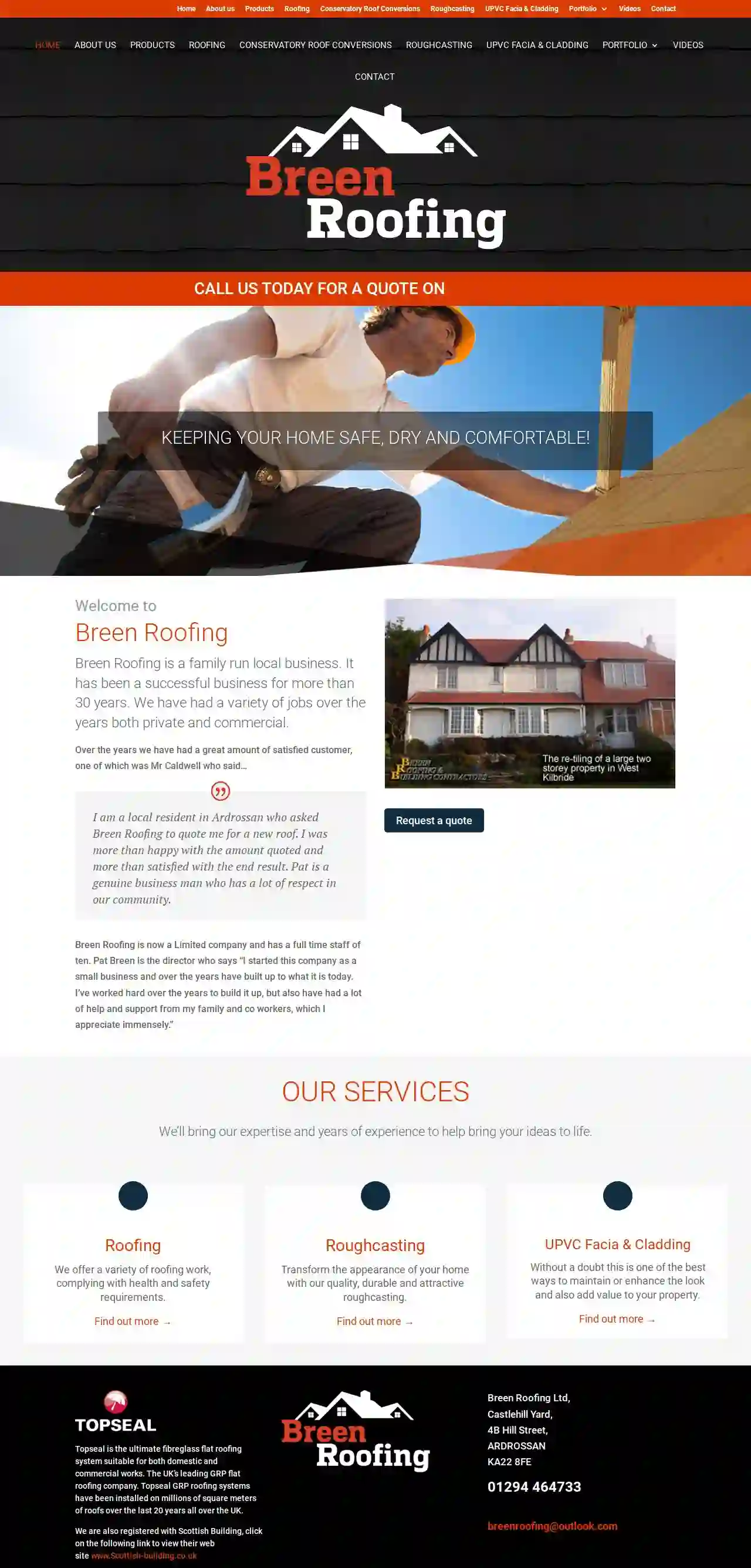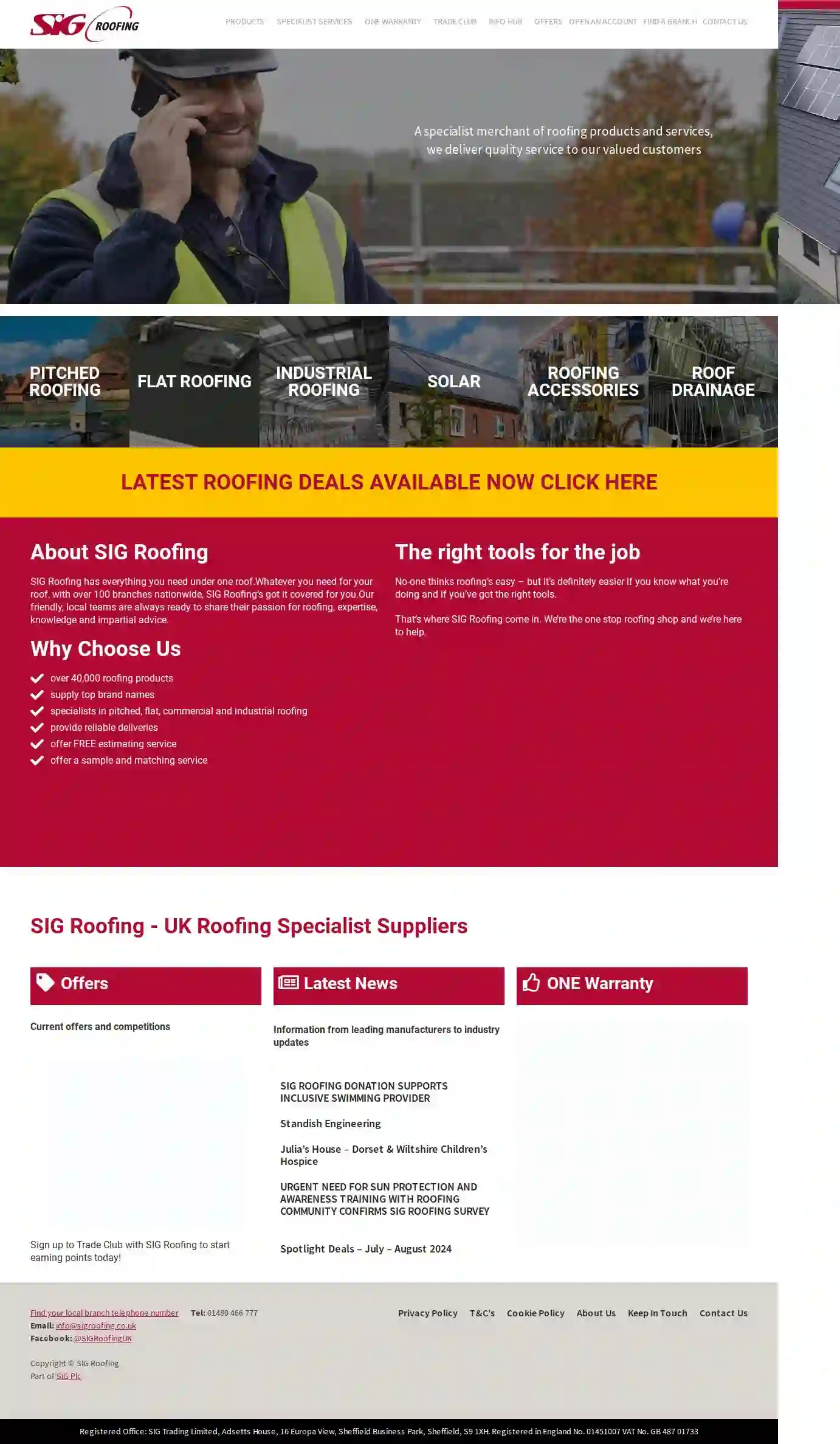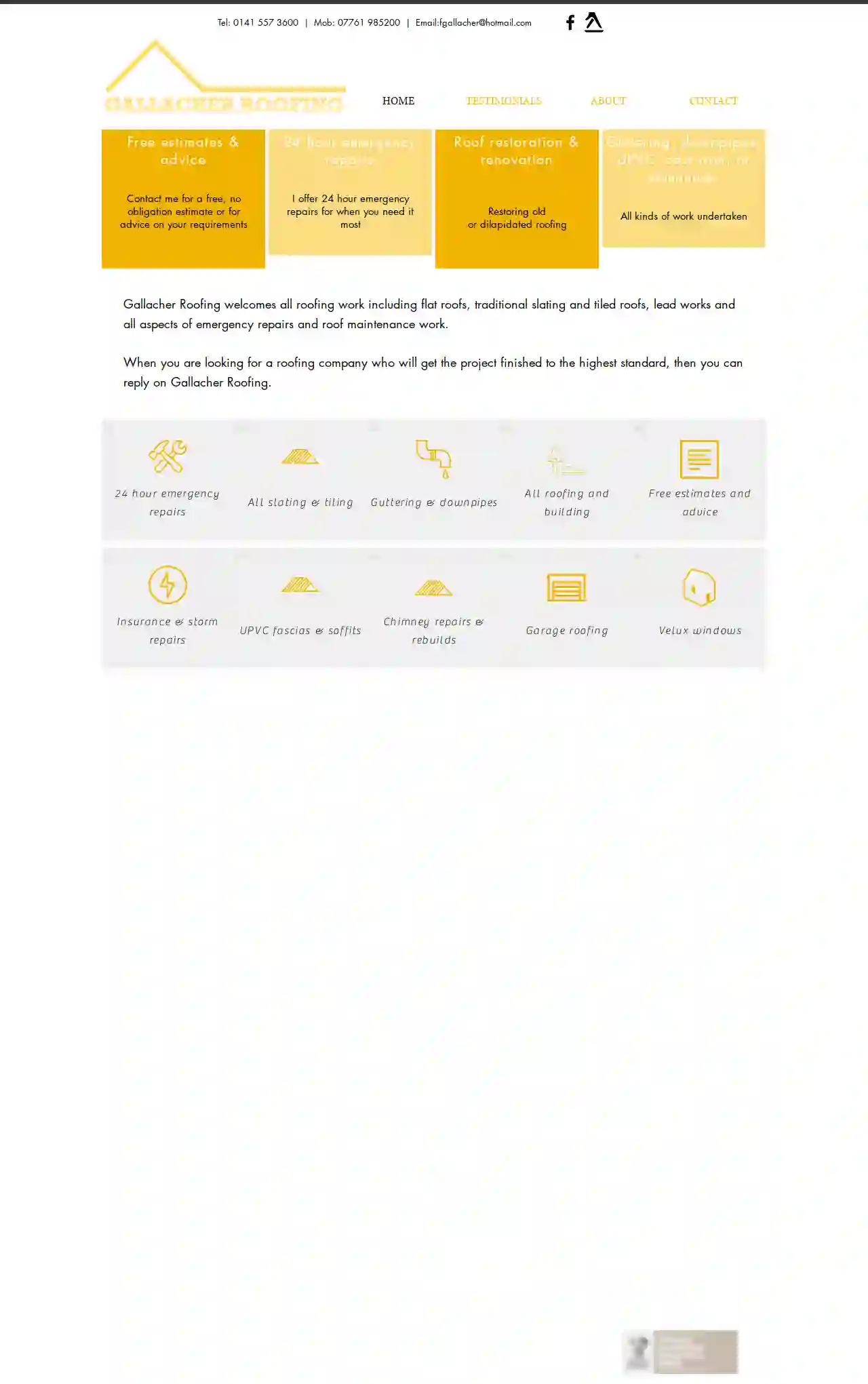Roofing Companies Stewarton
Find the best Roofers in Stewarton
Get up to 3 Roofing Services quotes for your project today! Compare profiles, reviews, accreditations, portfolio, etc... and choose the best deal.

Jmc roofing service
412 reviews123 Main Street, Brighton, BN1 1AA, GBJ.M.C Roofing is a family-run business with over 25 years’ experience in the roofing industry. We pride ourselves on providing a high-quality, reliable service at competitive prices. We cover all aspects of roofing, from small repairs to complete roof replacements. Our team of experienced roofers are fully qualified and insured, and we always use the best materials to ensure a long-lasting finish. We understand that your roof is one of the most important parts of your home, and we are committed to providing you with a roof that will protect you and your family for years to come. We offer a free no obligation quote on all our work, so why not get in touch today to see how we can help you.
- Services
- Why Us?
Get Quote
Breen Roofing
58 reviews4B Hill Street, Castlehill Yard, Ardrossan, KA22 8FE, GBBreen Roofing is a family-run local business with over 30 years of experience. We've successfully completed a variety of projects, both private and commercial. Our commitment to customer satisfaction is evident in the numerous positive testimonials we've received. One satisfied customer, Mr. Caldwell from Ardrossan, praised our competitive quotes and the high-quality workmanship. Breen Roofing has grown into a limited company with a dedicated team of ten employees. Pat Breen, the director, attributes the company's success to his hard work, the support of his family, and the dedication of his co-workers. We pride ourselves on providing a quality service, fast and reliable roofing solutions. Whether you need a new roof, roughcasting, UPVC facia and cladding, or a Topseal flat roofing system, our experienced team is here to help. Contact us today for a free quote and let us bring your roofing ideas to life.
- Services
- Why Us?
- Accreditations
- Our Team
- Testimonials
- Gallery
Get Quote
McMillan Roofing
32 Jamieson Road, Darvel, KA17 0BT, GBMCMILLAN ROOFINGYOUR FLAT ROOFING SPECIALISTSMCMILLAN ROOFING - YOUR FLAT ROOFING SPECIALISTS Here at McMillan Roofing, we have years of experience in flat roofing, and because that is all we specialise in you can be sure we know our stuff! Whether you are looking for a flat roof for a brand new build or you need your existing flat roof replaced or upgraded, we can help. Our flat roofing solutions are reliable, installed with precision and most importantly, give your roof outstanding protection for many years. No matter what the elements or time has to throw at it, you can be sure your roof will remain watertight and doing its job perfectly. High Quality Roofing Services at a Fair Price Our roofers have years of experience and will ensure that your roof is installed to the highest possible standard. Over the years we have installed countless roofs for our customers on both domestic and commercial properties. Our customers are always delighted with our professional service and high standards, and go on to recommend us to others. ROOFING SERVICESWE OFFER OUR FLAT ROOFING SERVICES ACROSS THE UK, AND ARE PROUD TO OFFER THE FOLLOWING OPTIONS FOR YOUR ROOF Built-Up Felt Roofing EPDM Roofing New Builds Single-Ply System Storm Damage & Repairs Seamless Liquid Plastic We take great care to select only the best products for our range, and with our expertise you can be sure we will apply them with precision. From our base in Darvel, we are able to travel across Scotland and the UK offering both routine and emergency roofing services. No matter where you are or which of our services you require, we are here to assist. The Flat Roofing Team You Can Trust There are many flat roofing companies in the area and it can be daunting to find the right company. We take the hassle and uncertainty away with our excellent track record and outstanding reputation. From Carlisle to Ayrshire, you can trust us to provide you with great quality service every step of the way.
- Services
- Why Us?
- Our Team
- Testimonials
- Gallery
Get Quote
W Milligan Roofing Ltd
54 reviews5 Craiglea Avenue, Kilmarnock, KA2 0JD, GBWe've been providing top quality roofing services throughout Ayrshire for over 25 years. W Milligan Roofing Ltd specialises in catering to all the roofing needs of clients in Glasgow, Kilmarnock and across Ayrshire. From fixing a small leak to a complete re-roofing, we can handle all your roofing needs. We only use superior quality materials for all the roofing projects we undertake. We also offer cladding, fascias, soffits and guttering. Our team of roofers go the extra mile to deliver quality services. At W Milligan Roofing Ltd, we have a team of dedicated and experienced roofers who have the expertise to undertake roofing projects of any size. We cover all aspects of roofing, from slate roofing to roof repairs.
- Services
- Why Us?
- Accreditations
- Gallery
Get Quote
I D Property Services
4.65 reviewsGBPeace of Mind We are an Ayrshire based local business, serving the central belt and beyond. Services Roughcasting Rendering UPVC cladding External Renovation No Sales team, Just Trades specialist We have NO sales team so you can ensure you will be liaising directly with an experienced tradesman who will offer you their extensive advice and expertise on every product which we offer. Full Customer Experience Service WE ensure that we commit to the time frames agreed and most of all deliver a service which exceeds our customers’ expectations. Ayrshire Roughcasting carry full employers and liability insurance. Our team are polite, respectful, and always courteous. Our team are QUICK, EASY and TIDY, ensuring maximum satisfaction for our customers with NO STRESS! At Ayrshire Roughcasting, we understand that a home is more than bricks and mortar, it is your family’s nucleus, where you eat sleep and make memories. We therefore make it our priority to ensure that your home is safe, secure and aesthetically pleasing too! We offer a wide variety of services in the home improvement sector, we are always happy to guide and advise our customers with any questions or enquiries that they may have. Our full range of services will provide not only protection and heat to your home, yet also gives a new lease of life to tired and outdated décor. We have a huge range of colours, textures and finishes to choose from which will compliment the style of your home. Our roofing services cover everything from UPVC fascia, soffits, guttering and led work. We also install full roofs and all roofing repairs. An added bonus to our services is our roof maintenance where one of our team will regularly inspect your roof and advise of any required repairs. We can do it all! Contact Us Ready to take the first step? Ayrshire Roughcasting are always looking for experienced tradesmen with extensive knowledge in the roughcast and rendering sector. If this sounds like you and you are looking for a new challenge in a fast paced environment then we would love to hear from you. Mobile: 07951 098051 Telephone: 01290 426451 Follow Us On:
- Services
- Why Us?
- Gallery
Get Quote
RF Watters Roofing & Building Contractors
4.315 reviews18 Dellingburn Street, Greenock, PA15 4TW, GBRF Watters is a well-established construction company that offers a variety of roofing and building services. Get in touch with us today for more information. Serving Inverclyde & Renfrewshire for 40 yearsWhether you are thinking of getting a new roof or converting a new room, at RF Watters, we can handle it all. Our team of efficient contractors have the necessary skills and training for completing both domestic and commercial projects on time and within your budget. No job is too big or too small for us. Based in Greenock, we serve customers across Inverclyde, Ayrshire and Renfrewshire. Get in touch Efficient ContractorsRF Watters is a family-run firm, established in the year 1978 and built on a strong reputation of quality workmanship and attention to detail. Our client base includes domestic properties, local authorities, housing associations, hospitals, schools and nursing homes. If you wish to find out more about our work, take a look at our gallery of images today.
- Services
- Why Us?
- Gallery
Get Quote
SIG Roofing Ayr
4.820 reviewsAyr, GBSIG Roofing is a specialist merchant of roofing products and services, delivering quality service to our valued customers. Established for over 40 years – with branches throughout the UK from Inverness to Plymouth. We have everything you need under one roof. Whatever you need for your roof, with over 100 branches nationwide, SIG Roofing’s got it covered for you. Our friendly, local teams are always ready to share their passion for roofing, expertise, knowledge and impartial advice.
- Services
- Why Us?
- Gallery
Get Quote
Norside Ltd
38 reviews21 St Mungo St, Bishopbriggs, G64 1QT, GBNorside is a roofing, general builders and multi trade company based in the Bishopbriggs area of Glasgow. Managing director Paul Smith started out as a sole trader, establishing Norside as a Limited company in 1996. Originally started as a roofing company, Norside has steadily progressed into general building and all trades, offering a varied service from roofing to refurbishments. We have a vast range of experience in all aspects of the construction industry. Norside deals with both private & commercial work. Renovations & extensions are carried out to the highest standard. We deal with all types of roofs and have over 30 years of experience. Over the last 25 years, Norside Ltd has moved into insurance works. Regular maintenance is important to properties, let us take care of it for you. Norside provides its own scaffold and scaffolders, who build and maintain the scaffold. Roof Maintenance Roofs are like cars and need maintained. Don't get caught out this winter. Call us now to book your annual roof maintenance check. 24hr Emergency Call Out Service – 07973634684 07812543545 07976321929 If you have a question, please contact at [email protected]
- Services
- Why Us?
- Our Team
- Gallery
Get Quote
RD Youngs Roofing Ltd.
526 reviews14 Carlisle Ct, Larkhall, ML9 2FD, GBR.D Young's LTD. is an experienced and professional roofing & guttering contractor based in Lanarkshire & Glasgow. We have years of experience in the construction & maintenance of roofing. If you require more information please don't hesitate to call or fill in the form below.
- Services
- Why Us?
- Gallery
Get Quote
Gallacher Roofing
34 reviewsGBGallacher Roofing is a roofing company that offers a wide range of services, including 24-hour emergency repairs, roof restoration and renovation, guttering and downpipes, and more. We are committed to providing our clients with the highest quality workmanship and customer service. We offer free estimates and advice on all roofing projects. Our team of experienced roofers is fully qualified and insured. We are also members of the National Federation of Roofing Contractors. Contact us today for a free quote!
- Services
- Why Us?
- Gallery
Get Quote
Over 12,314+ Roofing Businesses registered
Our roofing contractors operate in Stewarton & beyond!
Roofyng.co.uk has curated and vetted Top Roofers arround Stewarton. Find the most reliable business today.
Frequently Asked Questions About Roofing Companies
- Age: If your roof is nearing or exceeding its expected lifespan, it's wise to consider replacement.
- Multiple Leaks: Several leaks or leaks that reappear after repairs suggest a widespread problem.
- Extensive Damage: Large areas of damaged, missing, or deteriorated roofing materials might be too costly or difficult to repair effectively.
- Sagging or Structural Issues: Sagging, deflection, or other structural issues indicate a compromised roof that needs replacement.
- Granule Loss (Asphalt Shingles): Significant granule loss indicates weathering and reduced protection.
- Curling or Buckling Shingles: Signifies age or improper ventilation.
- Increased Energy Bills: A poorly insulated roof can lead to higher heating and cooling costs.
- Home Improvement Loans: Offered by banks or credit unions.
- Home Equity Loans or Lines of Credit: Use your home's equity as collateral.
- Government Programs: Check for energy efficiency rebates or grants.
- Contractor Financing: Some roofing companies offer financing plans.
What are the signs that my roof needs to be replaced?
How often should I clean my gutters?
How can I get financing for a new roof?
What should I do with my old roof after replacement?
What are the signs that my roof needs to be replaced?
- Age: If your roof is nearing or exceeding its expected lifespan, it's wise to consider replacement.
- Multiple Leaks: Several leaks or leaks that reappear after repairs suggest a widespread problem.
- Extensive Damage: Large areas of damaged, missing, or deteriorated roofing materials might be too costly or difficult to repair effectively.
- Sagging or Structural Issues: Sagging, deflection, or other structural issues indicate a compromised roof that needs replacement.
- Granule Loss (Asphalt Shingles): Significant granule loss indicates weathering and reduced protection.
- Curling or Buckling Shingles: Signifies age or improper ventilation.
- Increased Energy Bills: A poorly insulated roof can lead to higher heating and cooling costs.
How often should I clean my gutters?
How can I get financing for a new roof?
- Home Improvement Loans: Offered by banks or credit unions.
- Home Equity Loans or Lines of Credit: Use your home's equity as collateral.
- Government Programs: Check for energy efficiency rebates or grants.
- Contractor Financing: Some roofing companies offer financing plans.